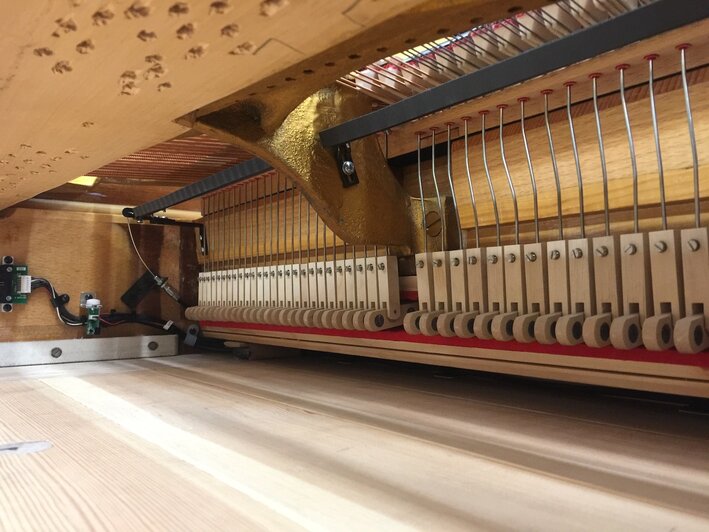Silent Piano Conversions & Sales
We can convert any of our Yamaha U1 or Yamaha U3 pianos to silent very quickly and easily and the results are very impressive. The piano becomes a hybrid with acoustic and digital capability.
View a 1-minute version of this video on Youtube, Facebook, Twitter, Instagram, Tiktok
Which kit do you use and what does it look like?
We use the very latest cutting-edge system from Ad Silent in Germany. It’s a remarkable system and is used by Petrov, Seiler and other high-end piano manufacturers on their brand new pianos. You can trust this system!
You can use your Smartphone or Tablet to change many of the settings according to your preferences.
Here is a video made by Petrov. You will see Andreas part-way through the video. He is the developer and we have been working with him for over 10 years. We like Andreas!
User Manual
You can download the user manual here
How much does it cost and how long does conversion take?
The conversion cost for an upright piano is £1990 and takes us 2 days to finish. The price for a grand piano is £2390. If your chosen piano is from our London showroom then it will take us a few days longer as we have to first bring the piano to our Manchester warehouse workshop. There is no extra cost for moving the piano from London to our Manchester workshop.
If you want us to convert your existing piano to silent then we may have to add on collection and redelivery fees so that we can complete the installation here in our Manchester warehouse (£300 for an upright, £440 for a grand). However, if you live within 30-50 miles of Manchester then we may be able to fit the system in your home to save you paying any delivery costs.
When to pay
We require payment in full before work can start on the silent conversion
Does it affect the touch?
The system uses optical sensors to detect key movements so there is no effect on the weight of the action. The hammers do have to be moved ever so slightly to make way for the mute rail that catches the hammers preventing them from hitting the strings when in silent mode. So there is a theoretical difference to the action setup but we’ve never had any complaints about the action feeling different after the conversion, even from highly accomplished concert pianists.
Does it replace the practise pedal?
The silent conversion process does not affect the practise pedal. You still get to keep the middle pedal functionality which lowers a piece of felt in front of the strings lowering the piano’s volume significantly.
Best Features of the system
Some of these features require the smartphone/tablet app which connects to the control unit via Bluetooth
- 88 key sensors 100% touchless (optical)
- 3 Pedal sensors as standard 100% touchless (optical)
- 247 Note polyphony
- Piano sound with 9 sample layers and 128 dynamiс levels
- 8 Preset User Sounds (Memory spaces for preferred combinations of sound and settings)
- A total of 127 sounds, including 5 x piano, 4 x e-piano, 1 x harpsichord, 1 x church organ, 8 other organ sounds
- Sound controls: tone, reverb, effect (chorus, rotary), delay, 4 band equalizer, transpose
- Metronome settings: beat, tempo, volume
- Recordings: 10 memory banks
- 10 Demo songs
- General settings for touch control (dynamic), note repeat limit, black key volume, individual key volume, tuning, auto sensor calibration, pedal switch point, key depth (upper and lower limits), continuous note-on, brightness of the control panel, piano type, tuning curve
- Bluetooth MIDI
- Control buttons for tone, metronome, recording, play, combined volume/on/off knob
- 2 × 3.5mm headphone jacks
- 3.5mm stereo line out
- Tuning: 440Hz +/- 13Hz
- 5 x LEDs indicating activity
- Control box with an adjustable viewing angle
- Control box dimensions: B: 143mm T: 79mm H: 27 mm
Is it available for grand pianos, too?
Yes, Adsilent make a similar system for grand pianos, too. The price is slightly higher but the results are the same. The only point to note here is that we have to drill a hole in the cast iron frame to fit the silent system to a grand piano. The hole is very small and is out of sight underneath the strings as shown in this photo:

How to recalibrate
We’ve made this video showing how to recalibrate the system if some of the keys sound strange.
============
This page is under construction. Here is the task list:
- Photo of the unit installed onto one of our pianos in our showroom
- Video demo










